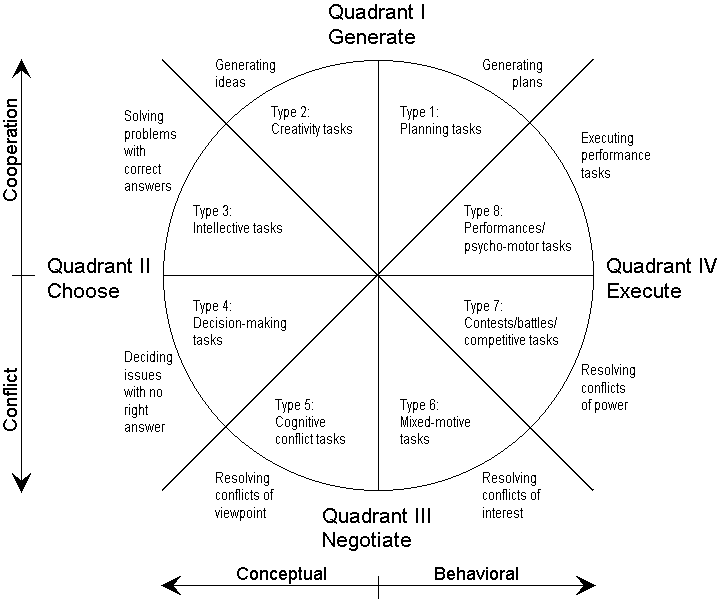A circumplex model of group task types
McGrath [1984] has combined
the main ideas of a number of scientists into a conceptually related set of
distinctions about tasks. His framework is presented here, together with some
of his remarks regarding a typology of tasks. McGrath
concludes that his task circumplex, as he calls his framework, represents
a reasonable attempt to classify group tasks: virtually all tasks used in group
research can be accomodated.

First, McGrath proposes that
there are four general processes. These processes make up the four quadrants
which are distinguished within the model. These are the labels for the particular
performance processes that are engaged by the task. They indicate what the group
is to do:
- to Generate (alternatives)
- to Choose (alternatives)
- to Negotiate and
- to Execute
In turn, these quadrants can be subdivided into two types of tasks each:
- Quadrant I: Negotiate
- Type 1: Planning tasks. Generating plans for actions. Key notion:
Action-oriented plan.
- Type 2: Creativity tasks. Generating ideas or images. Key notion:
Creativity. This category is related to the adjacent intellective problem category in
having an emphasis on cognitive matters.
- Quadrant II: Choose. The terms and distinctions in this quadrant are borrowed from
P. R. Laughlin.
- Type 3: Intellective tasks. Performing intellective tasks is about
finding a correct answer for a given problem. Examples of intellective
tasks are logic problems and other problem-solving tasks with correct but not
compelling answers; tasks for which expert consensus defines answers. Key notion: the correct answer.
- Type 4: Decision-making tasks. Typically, for these tasks, there is not
a demonstrably correct answer. The group's task is to select, by some consensus
(based on what is morally right or what is to be preferred), a preferred
alternative. Examples include tasks used in risky shift,
choice shift, and group polarisation studies.
Key notion: preferred answer.
Collaborative writing, the group task that The COOPerator should support, may be characterised as a creative and intellective task.
- Quadrant III: Negotiate. According to McGrath, this quadrant is more or
less an extension of quadrant II, Choose, under conditions where there is intra-unit
conflict. The key word here is not solve but resolve.
- Type 5: Cognitive conflict tasks. In this case, members do not just
have different preferences, but they have systematically different preference
structures. Key notion: resolving policy conflicts.
- Type 6: Mixed-motive tasks. In this category, a number of subtypes
may be distinguished. These range from those with an emphasis on resolution
(compromise or agreement) to those with an emphasis on power. Examples include
negotiations and bargaining tasks as well as coalition formation tasks. Key notion:
resolving pay-off conflicts.
- Quadrant IV: Execute. This quadrant deals with physical behaviour. Though
such tasks are very heavily represented in the workaday world, they are quite
underrepresented in research on groups according to McGrath.
- Type 7: Contests/battles. Contests are tasks for which the group is in
competition with an opponent or, in worse cases, an enemy. Performance results
are interpreted in terms of a winner and a loser. The pay-offs are interpreted in
those terms as well. Examples are competitive sports, all winner-take-all conflicts
and wars. Key notion: winning.
- Type 8: Performances. Performances that include those tasks do not
involve competition against an opponent, but rather involve striving to meet
standards of excellence with pay-offs tied to such standards. These tasks involve
complex sets of activities requiring coordination between members and over time.
Examples include many physical tasks (lifting, digging, pushing, etc.) and some
sports events.
The task circumplex is a two-dimensional representation. The horizontal
dimension shows a contrast between behavioral or action tasks to the right and
conceptual or intellectual tasks to the left. The vertical dimension reflects a
contrast between cooperation or facilitative compliance at the top and conflict or
contrient interdependence at the bottom.


Sjoerd Michels, Tilburg, The Netherlands

